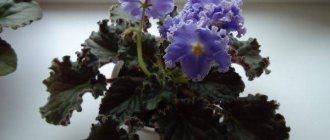Daisies are beautiful, romantic flowers that are often preferred by gardeners to decorate their garden landscapes.
Large garden daisies are easy to grow, they do not require special care and are perennial plants - which is not an ideal option for decorating your favorite garden. But before you grow a herbaceous plant, it doesn’t hurt to familiarize yourself with the basic conditions for growing healthy and flowering daisies.
Description of garden perennial chamomile
The brightest large-flowered plants are used to decorate flower beds.
Flower growers first became interested in daisies more than two hundred years ago, so many cultivated varieties have appeared over the years. And although perennial garden daisies can be of different heights, have different flowering times and inflorescence shapes, all daisies have much in common. First of all, this is a recognizable form of an inflorescence-basket, the core of which consists of small tubular yellow flowers, and the frame is made of false-ligulate petals.
Today, thanks to the efforts of breeders, semi- and double varieties of garden chamomile are available to gardeners.
Compared to wild specimens in cultivated perennials:
- flowers are larger;
- bud formation is much more active;
- the flowering period is longer;
- flowers may reappear in the second half of summer.
In early spring, a rosette of oblong basal leaves appears above the soil. When inflorescences appear on faceted, erect stems, the height of the plant can vary from 20 to 80 cm. Depending on the variety, the diameter of the inflorescences can reach from 3 to 10 cm.
Features of pyrethrum
Most types of pyrethrum are perennials. Among the many species there are also annuals. Ribbed branched shoots can be erect or ascending, with pubescence on their surface. The height of the stems is 0.6–1 m. Such plants have a very powerful root system that can penetrate 300 cm deep into the soil. The alternately arranged leaf plates are cut into narrow segments of varying widths. Their front side is green-gray, and their back side is gray-ash. The basal leaf plates have grooved petioles; they are a couple of times longer than the leaves themselves. The stem leaf plates also have petioles, which become shorter and shorter as they approach the tip of the shoot. The diameter of single baskets is from 50 to 60 mm; they are part of the corymbose apical inflorescences. The baskets include ligulate sterile marginal and small bisexual median tubular flowers, which are painted white, red and all shades of pink. Flowering occurs in May and June. The fruit is a pale brown achene with 5 to 10 ribs and a toothed or lobed crown. The seeds remain viable for 2 or 3 years.
Pyrethrum on my site
Growing chamomile from seeds
Sowing chamomile
Growing chamomile is possible in seedlings and without seedlings. You can sow garden chamomile seeds simply in the ground, but it is safer to use the seedling method.
Chamomile seeds are sown for seedlings in March. Trays with cells are filled with a moist, light, breathable substrate consisting of peat and sand in equal parts, 2-3 seeds are placed in each cell, sprinkled with a thin layer of substrate on top, the container is covered with a transparent film and placed close to the window, but not on window sill, since the light passing through the glass is too intense and can damage the seed germination process. Monitor the condition of the soil, and as soon as it dries, moisten it with a spray bottle.
Chamomile seedlings
When the seedlings begin to appear, and at normal room temperature this will happen in one and a half to two weeks, remove the film and place the container as close to a sunny window as possible, protecting the seedlings from drafts. If this is not possible for any reason, place a fluorescent lamp over the container, which should work for at least 14 hours a day. As soon as the chamomile seedlings reach a height of 5 cm, leave only one, the most developed seedling, in each cell.
Do not pull out unnecessary seedlings, but carefully pinch them off above the soil surface, because you risk damaging the root system of the remaining seedling. In order for chamomile to bush, pinch it over 3-4 leaves.
How to plant a large garden chamomile in open ground
Before planting garden chamomile, it is imperative to prepare the soil for more efficient absorption of the shrub, regardless of how it is grown.
The most successful option for transforming any soil into a favorable environment for any variety is considered to be fertilizing with universal flower fertilizers. They can be either organic (low concentration) or mineral. Although, if you wish, you can purchase special preparations for such purposes in the store.
When and how to plant?
If the method of sowing seeds was chosen for planting, it is better to start growing in March. It’s good if you plant the seeds not in open ground, but in special containers (disposable plastic cups can be used), because there they will germinate better and be better accepted on the site.
Seedlings are planted at the beginning of May, so that the plant has time to assimilate into the new environment.
When the ground is ready, holes are dug for planting, 20-30 cm deep with indentations of 20-40 cm from each other. After planting, the plant is watered abundantly with clean water or diluted means to stimulate growth.
Chamomiles will begin to bloom within a year.
When is the best time to replant garden chamomile?
September is a good time for transplanting and dividing bushes, since an adult plant is accepted quickly and already feels comfortable in a new place by the cold weather.
Caring for garden chamomile after planting
All types of chamomile, including garden chamomile, are light-loving. They do not tolerate proximity to groundwater and growing in dense, caking soil.
But at the same time, perennials, beloved by gardeners, are very undemanding to care and can grow even on soils poor in humus, tolerate drought and are not afraid of serious attacks by pests.
However, after planting garden chamomile, caring for them should be careful and systematic. Young plants need frequent watering until rooting is complete. Flowers that are firmly established in a new place are no longer so tender, and they are watered only in hot, dry weather.
The time for watering is chosen so that drops of water in the sun do not act as lenses and do not cause unsightly burns on the leaves and inflorescences.
To maintain soil moisture longer, the root zone is mulched with peat. In addition, the flowerbed is regularly weeded and the surface layer of the earth is loosened.
Although garden daisies are very unpretentious, lush flowering can only be achieved if the plants receive enough nutrition. Therefore, nitrogen fertilizers are applied under the roots in the spring. Wilted inflorescences must be cut off together with the stem. This will help keep the plant strong and decorate the area with white chamomile lace for a long time.
When flowering ends, flower care does not stop. Closer to autumn, adult clumps are divided, all old, dead parts are removed, flower stalks and dry leaves are cut out.
If the soil on the site is acidic, it must be deacidified in the fall using dolomite flour or lime.
Chamomiles are frost-resistant, but in winters with little snow they can freeze out, so before the cold weather the clumps are cut down to the ground and thickly sprinkled with peat, spruce branches or other suitable material.
In landscape design
Persian daisies can be used to frame flower beds. It is best to combine them with cosmos, cornflower and bluebell, basil and acroclinum. The plant fits ideally into areas decorated in country style.
Mixborders and ridges are decorated with variegated flowers. Often planted in flower beds for edging.
Next to ornamental bushes and trees, you can plant pyrethrum in separate independent islands. Or together with carnations of a more saturated color.
Chamomile propagation
Garden daisies are propagated by dividing the bush and by seed. Despite the fact that perennial daisies can grow in one place for five years, after 2-3 years the bushes become too dense, shoots die off in the middle of the bush, the size of the inflorescences decreases, and the plant loses its attractiveness. This can be avoided by promptly planting young, strong shoots from the bush. At the end of September or beginning of October, on a cloudy, cool day, separate a part from the bush and plant it in a prepared hole, spilled with settled water, and fill the resulting void with fertile soil.
Next time, dig up and replant part of the bush on the opposite side. This is how varietal and double daisies are propagated. If you want to achieve the largest flowers on powerful stems, you need to divide your daisy bushes annually.
Garden daisies also reproduce by seeds. We have described growing chamomile seedlings to you, but you can sow the seeds directly into the ground before winter. In cold soil they will undergo natural stratification and germinate together in the spring, and all you have to do is thin out the seedlings.
Great plant for the garden
Pyrethrum will decorate any garden plot. Flowers require minimal care and will delight the gardener with magnificent blooms for many years. The plant also has the name Caucasian or Persian flower. Despite the climate of the country of origin, pyrethrum grows and blooms well in other climates. During the adaptation period, which is about 200 years, pink chamomile began to feel good even in hot and dry areas.
A related flower is red pyrethrum, which is quite often confused with the Persian species.
They are similar because they have large inflorescences and rich red or bright pink petals (unlike ordinary daisies, which have white petals).
Breeders have worked on pyrethrum, so many varieties are now being bred.
The pink plant has a straight stem and does not grow higher than 150 cm (average length is 70 cm). The leaves look like dissected feathers and have different sizes. They become narrower towards the stem. Chamomile inflorescences grow up to 6 cm in diameter. Flowers can be reed or tubular. Pyrethrum begins to bloom in June or August and continues to delight gardeners with bright inflorescences for another 2 months.
Pests and diseases of daisies
With insufficient or irregular care, chamomiles have a chance of developing powdery mildew, gray mold, rust and fusarium.
Powdery mildew appears as a whitish coating on the above-ground parts of the plant, which gradually turns brown.
Rust appears as dark red spots on the upper side of the leaves, and on the lower side it forms pads with fungal spores.
Fusarium is also a fungal disease, in which the roots and root collar of young plants begin to rot, the tissues become brown, the stem becomes thinner, and the leaves turn yellow.
Gray rot is manifested by rapidly increasing in size brown necrotic spots on shoots and leaves. At high air humidity, the spots are covered with gray mycelium fluff.
To prevent fungal infection of flowers, do not allow excess moisture in the soil, promptly remove weeds and loosen the soil. It is better to immediately remove a specimen infected with gray rot so that the disease does not spread to neighboring plants.
They destroy fungal microflora with fungicides - Fundazol, Topaz, Kuproxat, Oksikhom and other drugs of similar action. Treatment is carried out two or three times with an interval of 7-10 days.
Among the pests, garden chamomile is affected by aphids, thrips, star-winged flies and wireworms.
The star-winged fly is so named because of the small star-shaped spot on its wing. Its larvae damage garden chamomile, accumulating at the base of the middle flowers. You can protect the planting of daisies from the appearance of this pest by regularly destroying weeds on the site.
Thrips and aphids are sucking insects that feed on the cell sap of the above-ground parts of the plant. Discolored or yellow spots, streaks and stripes appear on the leaves, damaged tissues die, leaves wither, fall off, flowers become deformed and lose their decorative effect. In the fight against aphids and thrips, insectoacaricides are used - Karbofos, Agravertin or Actellik.
Wireworms are the larvae of click beetles . They live in the soil for up to four years and feed on underground parts of plants. To get rid of them, traps are set in the soil: holes are dug into which pieces of potatoes, carrots or beets are placed. The top of the trap is covered with a board or piece of metal. After 2-3 days, the traps are opened and the wireworms that have accumulated in them are destroyed. This needs to be done regularly. Most often, wireworms appear if there is a plot of potatoes nearby.
Interesting Facts
- According to the modern dream book, if you dream of large chamomile flowers , a joyful event will happen soon, and weaving a wreath of daisies means happiness with your loved one.
- Large garden chamomile is a real find for florists : it does not fade in a bouquet for up to 10 days.
- Chamomile is a symbol of light, purity and fidelity , so it is no coincidence that it was chosen as the subject of fortune telling; For these purposes, since ancient times, the largest inflorescences have been selected, which established the plant as the most valued by lovers.
- Garden chamomile, like medicinal chamomile, easily relieves inflammation , has an antibacterial and sedative effect, and is also used to prepare teas and decoctions.











